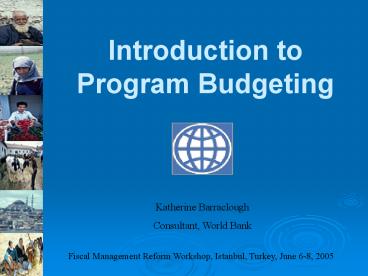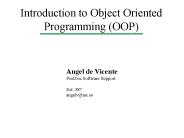Introduction to Program Budgeting - PowerPoint PPT Presentation
1 / 26
Title:
Introduction to Program Budgeting
Description:
Introduction to Program Budgeting Katherine Barraclough Consultant, World Bank Fiscal Management Reform Workshop, Istanbul, Turkey, June 6-8, 2005 – PowerPoint PPT presentation
Number of Views:130
Avg rating:3.0/5.0
Title: Introduction to Program Budgeting
1
Introduction to Program Budgeting
Katherine Barraclough Consultant, World Bank
Fiscal Management Reform Workshop, Istanbul,
Turkey, June 6-8, 2005
2
Outline
- What is program budgeting and what is it good
for? - Program budgeting in Korea a case study of the
Ministry of Environment - Some general considerations for successful
implementation
3
What is program budgeting and what is it good for?
4
Defining Program Budgeting
- Resource allocation based on priorities
- Allocating budgetary resources according to
government policy objectives and priorities - Focus on organizational objectives
- Focus on outputs/outcomes
- Allocate expenditure by program
- Assess results based on objectives
- Applicable for cost-benefit analysis
Programs are groupings of government activities
in relation to specific government objectives
(IMF Manual for Fiscal Transparency)
5
Key Elements of Program Budgeting
- Sets programs as the basis for budget
appropriations - Focus shifts from line items to programs
- Basis for facilitating a cost allocation system
- Prompts line ministries to define objectives and
match activities and resources to achieving them - Usually tied to their legal mandate
- Tool for granting greater autonomy and
responsibility - In line with transparency and accountability
6
Benefits of Program Budgeting
- Basis for supporting enhanced fiscal discipline
- Facilitates decision-making for resource
allocation - Organizes budget around government policy
priorities - Acts as a mechanism for focusing on operational
efficiency and performance - Enhances transparency and is user friendly for
legislature and general public - Enhances control and accountability for the CBO
- Affords greater autonomy and flexibility to
spending agencies
7
Program Budgeting in Korea
- A Case Study of the Ministry of Environment
8
MoEs Organizational Structure
9
General Principles (1)
- Align the budget classification with that of the
NFMP - Integrate a mid-term perspective into the annual
budget - Keep programs within the organizational structure
- Clarify lines of accountability and program
management - Combine all activities according to program
objectives - Regardless of revenue source
10
General Principles (2)
- Determine appropriate scope and number of
programs - Reflect ministrys role and areas of
responsibility - Limit the number of activities
- Keep at a level that allows for in-depth, policy
oriented analysis - Simplify the object groupings
- Facilitate discretion and limit excessive input
details that impede focus on outputs/outcomes
11
New Budget Structure (1)
- Reduces classification levels from 8 ? 5
- Places ministerial classification outside the
structure - But all groupings from sub-function down will be
organized within ministerial units - Provides the basis for resource allocation
decision-making - Links the budget structure to performance
management
12
New Budget Structure (2)
13
Conceptual Framework
14
Suggested New Structure
15
Features of the New Structure
- 1 function, 5 sub-functions, 16 programs
- each sub-function has 2-5 programs
- Offices and bureaus have separate programs
- for clear lines of accountability and discretion
- Programs include all revenue sources
- number of activities per program at no more than
about 10 - Environmental Administration is a separate
program - due to costing difficulty of expenses
16
Sub-function (1)
- Promoting environmental policies for sustainable
development - Currently 116 activities
17
Sub-function (2)
- Increase the amount and quality of safe water,
and improve water quality in waterways and rivers - Currently 137 activities
18
Sub-function (3)
- Provide clean and clear air quality
- Currently 24 activities
19
Sub-function (4)
- Preserve and restore the natural environment for
a clean environment and improved quality of life - Currently 23 activities
20
Sub-function (5)
- Safe and hygienic waste management and the
promotion of recycling and reducing waste in
society - Currently 19 activities
21
Implementation Issues for Korea
- Co-operation between the CBO and spending
agencies - Consensus and commitment at high level
- At executive and legislative level and among key
stakeholders - Detailed reform blueprint
- Clarify PB in context of broader PEM reforms
- Piecemeal approach
- Gradual but steady
- Development of a policy- and performance-oriented
institutional culture - Identify need for reforms in institutional
culture - Ensure spending agencies design their own program
budget with cooperation from CBO
22
Considerations for Successful Implementation
23
Development Process
- Changing form and behaviour
- Thinking differently about planning, managing and
budget - Effective PB cannot be developed centrally
- Sense of ownership on the part of line ministries
- Line ministry staff must undertake the work
- Creating ownership and changing organisational
culture - Be cautious of other countries examples
- Unique laws and institutions, policies and
objectives - Establish stability in classification structure
- Continuity and consistency
- Generates demand for information and resources
- Creates need for additional or new data
collection, IT and data collection systems
24
Design Process
- Programs need to be within ministries
- Clearer linking of activities, funds, and
objectives for increased managerial
accountability - A program classification doesnt obviate the need
for other classifications - Classifications are added to meet new demands for
new information and new roles for the budget
process - Full costs need to be allocated to programs
- Incomplete cost information impedes management
and budget decision-making - Program concept should integrate recurrent and
capital budgets - Account for all inputs leading to outputs or
outcomes
25
Reform Management (1)
- Dont undertake as a budget cutting measure
- prompts resistance from line ministries
- Annual budget ceilings can help motivate
ministries - impetus to rationalise and relate activities to
objectives - Provide ample support to ministries
- tools for developing program structure and to
review spending priorities - Logframe logical framework
- Logic Model - Program Logic Model
26
Reform Management (2)
- Program budget implementation will be an
iterative process over several years - Trend lines or multiple data points allowing for
questions of efficiency and effectiveness - Selling program budgeting
- Matching expectations to reality of what can be
achieved in the time given - High-level commitment over time
- Utilisation of program structure by the central
budget authority for decision-making































